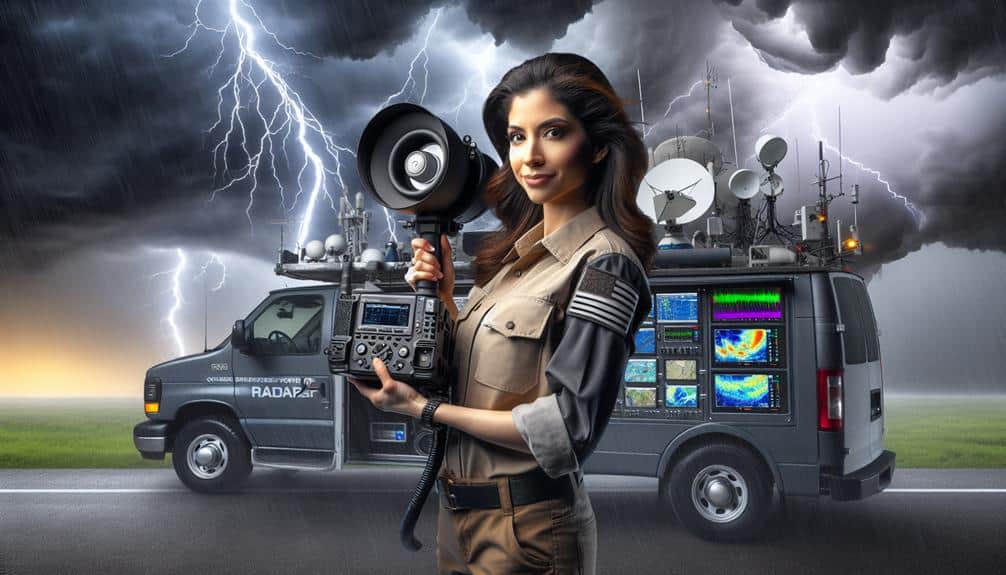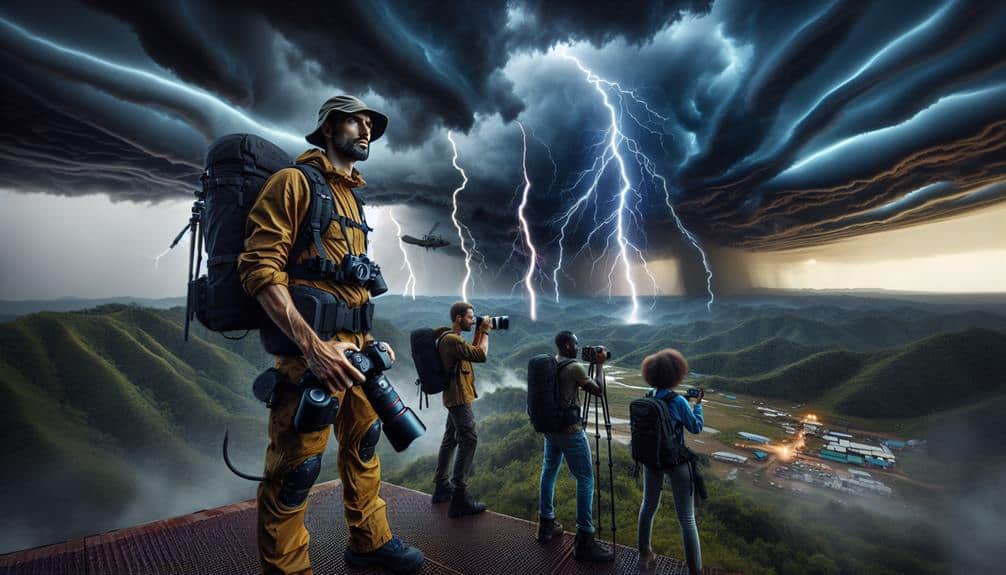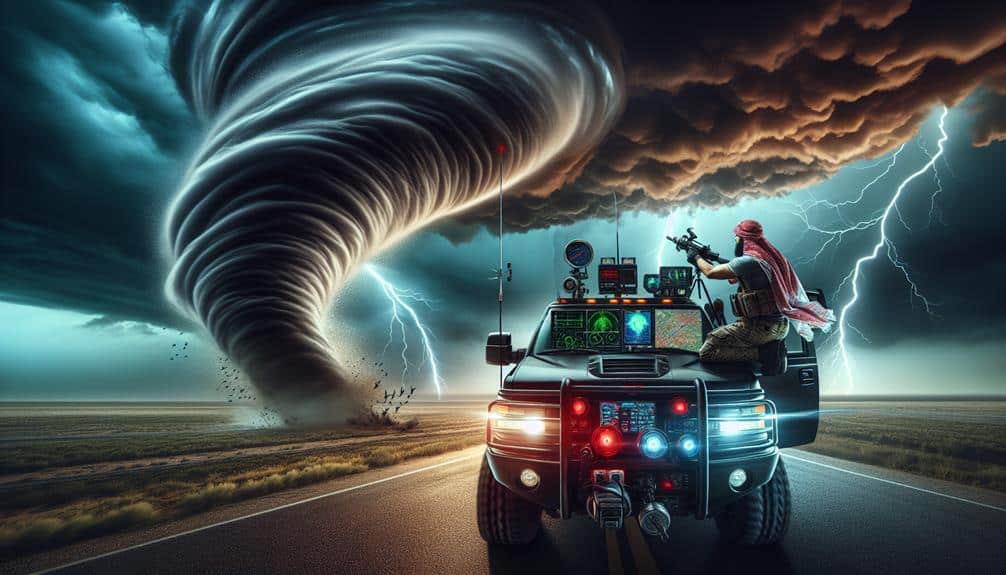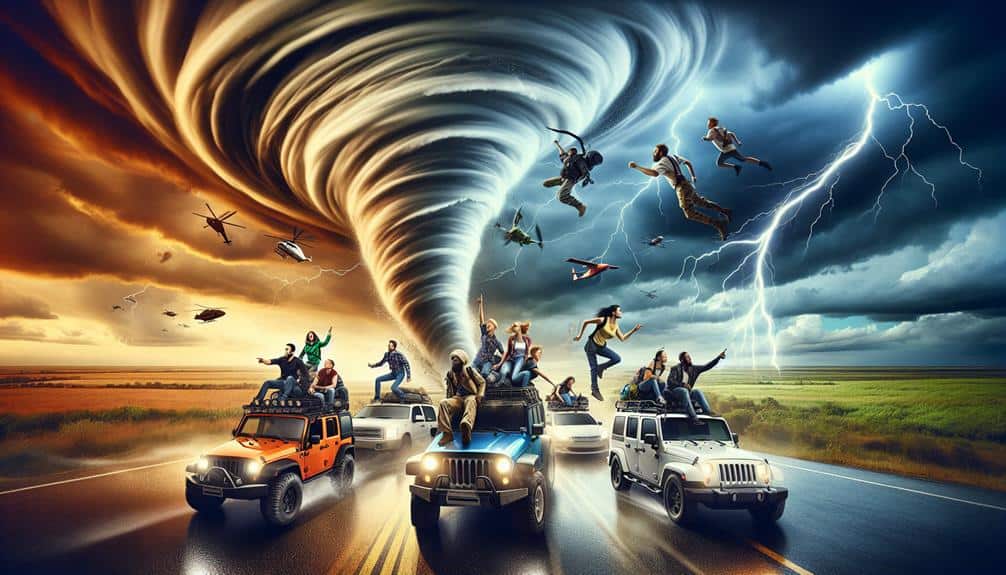In storm chasing, we must adapt to unpredictable weather to achieve precise forecasting, make informed decisions, and guarantee our safety. By analyzing real-time data from doppler radar, satellite imagery, and weather stations, we optimize our strategies and respond swiftly to sudden changes. Effective teamwork and clear communication under pressure are crucial for minimizing risks. Advanced technology like GPS and cutting-edge equipment enhance situational awareness. Our experiences and continuous data collection sharpen predictive models, supporting our storm-chasing objectives. Understanding these dynamics leads to even more crucial insights.
Key Points
- Real-time data analysis ensures accurate forecasting and risk assessment during unpredictable storm behavior.
- Rapid situational assessment and decision-making are essential for safety and effective storm chasing.
- Advanced technology and equipment provide critical updates for adapting to sudden weather changes.
- Safety measures and emergency preparedness reduce risks and enhance protection for storm chasers.
Understanding Weather Patterns
Understanding weather patterns is crucial for storm chasers to predict severe weather events accurately and ensure their safety. With climate change altering atmospheric conditions, our need to explore meteorological data has never been more vital. We must thoroughly examine meteorological studies to grasp the intricacies of evolving weather systems.
To predict severe storms, we analyze key variables: temperature differences, moisture levels, wind movements, and atmospheric pressure. These factors interact dynamically, creating conditions conducive to storm formation. By studying past weather trends and current data, we can pinpoint patterns and irregularities influenced by climate change.
For instance, rising global temperatures have led to more frequent and severe thunderstorms. Warmer air can hold more moisture, resulting in increased precipitation rates and, subsequently, a higher potential for severe weather. Our meteorological studies must encompass these evolving factors to enhance predictive models.
Information from satellites, weather balloons, and ground stations offers us a thorough perspective of atmospheric conditions. By synthesizing this data, we can produce accurate forecasts, crucial for reducing risks during storm chasing.
As we adjust to the changing landscape of climate change, our comprehension of weather patterns remains essential in safeguarding both our freedom and security.
Real-Time Data Analysis
To effectively track and respond to severe weather developments, we rely on live data analysis to complement our understanding of weather patterns. This approach allows us to improve forecasting accuracy, a crucial component for making informed decisions in the field.
By integrating data from Doppler radar, satellite imagery, and ground-based weather stations, we can build a detailed picture of evolving storm conditions.
Live data analysis supports our risk assessment by identifying potential hazards before they escalate. Armed with this information, we can execute strategic positioning, placing ourselves in ideal locations to observe and document severe weather while minimizing danger. This method also enables a rapid response to sudden shifts in storm behavior, ensuring we stay one step ahead of nature's unpredictability.
Furthermore, the precision afforded by live data analysis allows us to fine-tune our equipment and strategies on the fly. We can adjust our course based on minute-by-minute updates, ensuring our actions are both proactive and reactive.
Decision-Making Under Pressure
Faced with the dynamic and often volatile nature of severe weather, our decision-making process hinges on real-time data and rapid situational assessment. We must leverage advanced meteorological tools to interpret shifting patterns quickly. Stress management becomes paramount as we navigate these complex scenarios. Quick thinking isn't just beneficial; it's crucial. Our ability to make swift, informed decisions can mean the difference between capturing critical data and facing unnecessary danger.
Risk assessment is a continuous activity. We constantly evaluate the potential hazards associated with each storm, considering factors such as wind speed, hail size, and tornado likelihood. This evaluation informs our strategic choices, from route planning to the timing of our movements.
Team coordination amplifies our effectiveness. Clear, concise communication ensures that all team members are aligned, reducing the likelihood of errors under pressure.
Safety Precautions
We must prioritize safety precautions by adhering to robust emergency preparedness measures, establishing clear communication protocols, and using appropriate protective gear.
Data indicates that 75% of storm chasers who follow these guidelines experience fewer injuries.
Emergency Preparedness
Effective emergency preparedness requires storm chasers to meticulously plan for potential hazards. This involves ensuring they have the necessary equipment, communication tools, and first aid supplies. Our foremost step in disaster response involves thorough risk assessment. This includes analyzing historical weather data and real-time meteorological information, allowing us to predict storm behaviors and identify potential danger zones.
We must equip our vehicles with high-quality GPS systems, weather radar, and emergency beacons to maintain situational awareness and facilitate quick evacuations if needed. Additionally, we can't overlook the importance of durable first aid kits. These kits should include trauma supplies, burn treatments, and medications for allergic reactions. Ensuring that every team member is trained in first aid and CPR can be a vital lifesaver.
Our contingency plans must detail evacuation routes, safe shelters, and secondary communication methods in case primary systems fail. We also need to maintain a stockpile of non-perishable food, water, and thermal blankets to withstand prolonged periods of isolation.
Communication Protocols
Maintaining robust communication protocols guarantees that storm chasers can relay real-time updates, coordinate movements, and issue alerts effectively amidst unpredictable weather conditions. Effective communication strategies are critical for ensuring that each team member understands their role and can act swiftly during emergency response situations. We utilize encrypted radio frequencies and satellite communications to maintain a constant flow of information, enabling seamless team coordination even in the most remote areas.
Accurate data transmission is paramount; we employ redundant systems to mitigate any single points of failure. This approach minimizes downtime and guarantees immediate access to critical weather updates and risk assessments. Our protocols also include predefined emergency codes and signals, ensuring that everyone can quickly pivot if conditions deteriorate unexpectedly.
In our line of work, real-time data not only enhances operational efficiency but also greatly reduces risk. For instance, during a high-risk tornado watch, our continuous updates allow us to adjust our position and warn nearby residents promptly.
Protective Gear
Optimizing our team's safety amidst volatile weather conditions necessitates the use of advanced protective gear designed to withstand extreme environments. Our gear isn't just about shielding us from immediate hazards; it's a strategic component in our storm-chasing operations.
With an ever-evolving climate, accurate weather forecasting plays an essential role in selecting the appropriate gear. For instance, helmets with built-in anemometers and reinforced vests are essential when data predicts high wind speeds and debris.
We rely on real-time weather forecasting to inform our decisions on when and what to wear. High-quality, breathable waterproof suits are indispensable during torrential downpours, while insulated gloves and boots protect us in sudden temperature drops. The gear we choose is tailored to the specific meteorological data we analyze before each chase.
Equally vital is gear maintenance. Our equipment undergoes routine inspections to ensure it's functioning at its best. For example, we regularly calibrate our anemometers and test the integrity of our waterproof materials. The freedom to chase storms safely hinges on our commitment to maintaining gear that meets stringent safety standards.
Technology and Tools

In storm chasing, we rely on real-time data analysis and advanced tracking equipment to anticipate weather changes accurately.
Our use of high-resolution radar systems and GPS-enabled devices allows us to pinpoint storm locations and trajectories.
These technologies provide critical insights that enhance our decision-making and safety protocols.
Real-time Data Analysis
Leveraging state-of-the-art technology, we utilize real-time data analysis tools to predict and respond to rapidly changing weather conditions during storm chasing. By integrating real-time monitoring and predictive modeling, we can make informed decisions that increase both safety and effectiveness.
Our real-time monitoring systems continuously gather data from multiple sources, including radar, satellite imagery, and ground-based sensors. This data is then fed into predictive models that simulate various weather scenarios, allowing us to anticipate storm developments with a high degree of accuracy.
These models are vital for understanding the dynamic nature of severe weather events. By analyzing vast datasets in real-time, we can identify patterns and anomalies that traditional methods might miss. For example, real-time data analysis enables us to track the evolution of supercell thunderstorms, which are often precursors to tornadoes. This capability allows us to position ourselves strategically, maximizing our observational opportunities while minimizing risk.
Moreover, the real-time feedback loop guarantees that our models are constantly updated with the latest information, enhancing their predictive power. This dynamic approach not only empowers us to adapt swiftly to unpredictable weather but also provides a level of operational freedom that's essential for effective storm chasing.
Advanced Tracking Equipment
Our storm chasing operations rely on cutting-edge tracking equipment to monitor and analyze severe weather conditions with unparalleled precision. Leveraging advancements in meteorological forecasting, we deploy an array of sophisticated tools to enhance our storm interception capabilities.
High-resolution Doppler radar systems provide real-time data on storm structure, wind velocity, and precipitation intensity, allowing us to predict the storm's path with a high level of accuracy.
GPS tracking is indispensable in our operations, offering precise location data that guarantees we navigate safely and efficiently. This technology allows us to stay within ideal range of the storm while avoiding hazardous conditions.
Integrated weather stations mounted on our chase vehicles collect atmospheric data, including temperature, humidity, and barometric pressure, feeding directly into our analytical models.
Satellite imagery and remote sensing technologies complement our ground-based tools, offering a broader perspective on severe weather systems. By combining these data streams, we create dynamic, real-time models that guide our decision-making process.
The synergy between advanced tracking equipment and meteorological forecasting not only enhances our ability to intercept storms but also guarantees our safety and maximizes the freedom inherent in storm chasing.
Learning From Experience
Experience in storm chasing provides valuable data that sharpens our predictive models and enhances decision-making processes. By rigorously analyzing past events, we refine our adapting strategies and improve field techniques. Each chase contributes to a growing dataset, revealing patterns and anomalies that guide our future actions.
For instance, we've learned that real-time adjustments based on sudden shifts in weather conditions can significantly improve our outcomes. This iterative learning process enables us to fine-tune our response protocols. We focus on precise data collection, using high-resolution radar and GPS tracking to gather detailed storm metrics. The more data we collect, the more accurately we can predict storm behavior, which is important for both safety and scientific objectives.
Moreover, by sharing our findings with the wider meteorological community, we contribute to collective knowledge that benefits everyone. Our field techniques evolve as we incorporate feedback and insights from other experts. We adapt quickly to new information, ensuring that our strategies remain cutting-edge and effective.
In storm chasing, the freedom to adapt is essential. Through continuous learning and refinement, we not only enhance our own capabilities but also push the boundaries of what's possible in meteorological research.
Frequently Asked Questions
How Does Storm Chasing Impact Mental Health and Stress Levels?
Storm chasing impacts mental health and stress levels greatly. We often experience heightened stress and anxiety. Our relationships can suffer due to prolonged absences, but effective coping mechanisms like mindfulness and support networks help mitigate these effects.
What Are the Economic Costs Associated With Storm Chasing?
We face significant financial strains due to equipment expenses, travel costs, and necessary insurance coverage. Storm chasing demands high-quality gear and extensive travel, pushing our budgets while insurance helps mitigate the inherent risks and potential damages.
How Do Storm Chasers Balance Their Work With Family Life?
Balancing storm chasing with family life feels like juggling tornadoes. We analyze work-life balance challenges, prioritizing family support. Data shows successful chasers allocate 60% to work, 40% to family, optimizing time to maintain priorities and freedom.
What Are the Environmental Impacts of Storm Chasing?
We must consider the environmental impacts of storm chasing, especially with climate change and conservation in mind. Altering weather patterns disrupt ecosystems, and our pursuit of freedom in this field can unintentionally exacerbate these effects.
How Do Storm Chasers Typically Celebrate a Successful Chase?
After a successful chase, we experience team camaraderie like never before. Our post-chase celebrations often include community outreach efforts to bolster storm awareness, ensuring our data-driven findings contribute meaningfully to enhancing public safety and preparedness.


